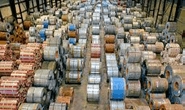Market

April 11, 2019
Signs that Secondary is Springing Forward
Written by Tim Triplett
Following a slower than expected first quarter, activity has begun to pick up in the nonprime/secondary steel market, report service center executives.
“Maybe that’s good news for April going forward,” said Lisa Goldenberg, president of Delaware Steel of Pennsylvania, Fort Washington, Pa.
Nonprime or secondary steel includes coils that are rejected because they failed to meet the specifications for their original use, but may be suitable for other customers with alternative applications.
Delaware Steel saw its volume decline by about 10 percent in the first quarter, while margins were off considerably, “so the combination was a double whammy,” Goldenberg said. But order activity seems to be improving now that winter has subsided. “We haven’t been able to get price increases yet, but the volume seems to be picking up.”
Secondary prices normally track up and down with prime steel prices. SMU’s average benchmark price for prime hot rolled has dipped to around $675 per ton. One reason may be weak ferrous scrap prices, which have moved downward or sideways in three out of the first four months of 2019. Goldenberg is hopeful that secondary prices will improve with the renewed seasonal demand. “At this point in the year, when scrap comes down in the spring, we sometimes see this decoupling between steel prices and scrap prices. I think that is what we are looking at.”
Uncertainty over tariffs and trade is adding to the usual competitive pressures, Goldenberg said. “I have never been this stressed. How much should we buy? Will the tariffs stay or will they go? Our customers are hesitant to commit because they feel the uncertainty as well.”
“There’s still a fair amount of uncertainty and speculation and skepticism in the marketplace for both prime and nonprime markets,” said Mike Barnett, president of Grand Steel Products, Wixom, Mich. “We’re keeping an eye out for potential black swan events, such as the removal of Section 232 or other changes in tariffs that could bring the price of steel down.”
The uncertain nature of the market brings a bit more restraint to purchasing decisions by both service centers and their customers, Barnett said. At Grand Steel, the seasonal pickup in activity still seems a bit delayed. The service center is quoting a lot of orders, “but it seems like the quoting is getting more and more competitive, and we have to go lower and lower to get the orders,” Barnett said.
Grand Steel has seen some of its larger tubulars customers buy direct from the mills at a price difficult for a service center to match. “The tubers have told us they were able to go mill direct and get some deals over the last two quarters. I don’t think there is significant tightening going on, the mills just see it as a good way to fill in some holes.”
Barnett expects to meet soon with Nucor representatives to discuss the ramp-up of the new Nucor Steel Gallatin pickling and galvanizing line in Ghent, Ky. The line, designed to produce 500,000 tons of galvanized hot strip per year, is expected to begin production possibly in the second quarter. (Nucor was unable to provide SMU with an update on the project at this time.) Startup of a complex new coating line will undoubtedly add some secondary coils to the market as the mill works out the bugs. “We’re interested to see if there are any startup deals we can put together with them,” Barnett said.
Other distributors report that secondary and nonprime material is generally in ample supply, though the competition for the most desirable coils—the ones with the most alternative applications—is stiff. That includes galvanized from 14-18 gauge and 20-gauge cold roll, said one distributor. And the spread between the cost of these high-demand secondary items and prime material is modest.
Said another distributor in the Midwest: “We are seeing a lot of excess/secondary available in the market and have been able to find whatever we need. Demand is steady, but orders are weaker than six months or a year ago. Pricing is not as competitive as it should be given the demand. While pricing is steady, we are not sure if we have just hit a lull or if there is still room for it to drop.”
The post Signs that Secondary is Springing Forward appeared first on Steel Market Update.






